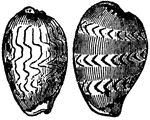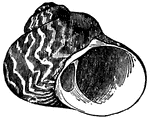Clipart tagged: ‘snail sea shell’

Buccinum Senticosum (Linnaeus)
"The Purpuras have a classical name and history, having furnished the Greeks and Romans with the brilliant…
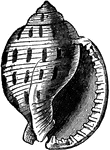
Cassis Canaliculata (Brugieres)
"In the genus Cassis the shell is oval, convex, and the spire is not of considerable height.…
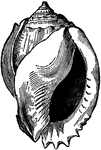
Cassis Glauca (Linnaeus)
"In the genus Cassis the shell is oval, convex, and the spire is not of considerable height.…
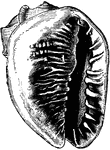
Cassis Madagascariensis (Lamarck)
"In the genus Cassis the shell is oval, convex, and the spire is not of considerable height.…

Cassis Madagascariensis (Lamarck)
"In the genus Cassis the shell is oval, convex, and the spire is not of considerable height.…

Cassis Rula (Linnaeus)
"In the genus Cassis the shell is oval, convex, and the spire is not of considerable height.…

Cassis Zebra (Lamarck)
"In the genus Cassis the shell is oval, convex, and the spire is not of considerable height.…

Cerithium Aluco.
"There are some species which are chiefly found in the muddy bottoms, and more frequently at the mouths…
Cerithium Fasciatum (Brug.)
"There are some species which are chiefly found in the muddy bottoms, and more frequently at the mouths…
Cerithium Giganteum (Lamarck)
"There are some species which are chiefly found in the muddy bottoms, and more frequently at the mouths…
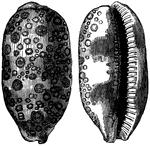
Cypraea Argus (Linn.)
"The Cowries are found at a little distance from the shore, generally in clefts of the rocky bottoms;…
!["The Madagascar Cowry [is] beautifully marked, having the general appearance of being mammillated all over."](https://etc.usf.edu/clipart/51500/51521/51521_cypra_madaga_mth.gif)
Cypraea Madagascariensis (Gmel.)
"The Madagascar Cowry [is] beautifully marked, having the general appearance of being mammillated all…

Cypraea Moneta (Linnaeus)
"The Money Cowry is a little, oval shell, depressed, flat below, with very thick edges and slightly…
!["The Granular Cowry [is] beautifully marked, having the general appearance of being mammillated all over."](https://etc.usf.edu/clipart/51500/51525/51525_cypra_nucleu_mth.gif)
Cypraea Nucleus (Linnaeus)
"The Granular Cowry [is] beautifully marked, having the general appearance of being mammillated all…

Cypraea Tigris (Linnaeus)
"The animal which inhabits these shells is elongated, and is provided with a well-developed mantle,…
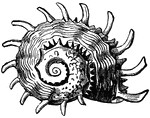
Delphinula Sphaerula (Kiener)
"The Monodonta are elegantly marked shells. Some curious specimens from this family come from…
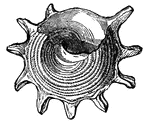
Imperator Stella (Lamarck)
"The Monodonta are elegantly marked shells. Some curious specimens from this family come from…

Imperator Stellaris (Lamarck)
"The Monodonta are elegantly marked shells. Some curious specimens from this family come from…
Mitra Episcopalis (Lamarck)
"The Episcopal Miter, from the Indian ocean is white, ornamented with square spots of a fine red, and…

Mitra Papalis (Lamarck)
"The Papal Miter has dentiform folds around the opening, which also crown each turn of the spiral. It…

Oliva Erythrostoma (Lamarck)
"The genus Oliva is so named from its resemblance in form to the olive. They are flesh-eaters."

Oliva Peruviana (Lamarck)
"The genus Oliva is so named from its resemblance in form to the olive. They are flesh-eaters."

Oliva Porphyria (Lamarck)
"The genus Oliva is so named from its resemblance in form to the olive. They are flesh-eaters."
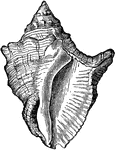
Purpura Consul.
"The Purpuras have a classical name and history, having furnished the Greeks and Romans with the brilliant…
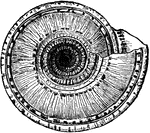
Solarium Perpectivum (Bottom View)
"The Staircase-shell is recognized by its deep umbilicus, wide and funnel-shaped, in the interior of…

Solarium Perpectivum (Side View)
"The Staircase-shell is recognized by its deep umbilicus, wide and funnel-shaped, in the interior of…
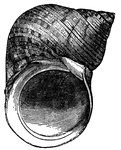
Turbo Imperialis (Gmel.)
This specimen comes from the Chinese seas. It is green on the outside, and brilliantly nacred within.
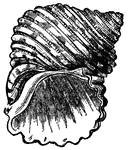
Turbo Margaritaceus (Linnaeus)
"A large thick and weighty shell, round-bellied and deeply furrowed; it is yellow, or rust-colored,…

Turbo Marmoratus (Linnaeus)
"The Marbled Turbo is the largest shell in the group. It is marbled green, white and brown outside,…
Turritella Angulata (Sowerby)
"Some other species, the names of which indicate a winding pyramid, have shells terminating in a sharp…
Turritella Goniostoma
"Some other species, the names of which indicate a winding pyramid, have shells terminating in a sharp…
Turritella Replicata (Linnaeus)
"Some other species, the names of which indicate a winding pyramid, have shells terminating in a sharp…
Turritella Sanguinea (Reeve)
"Some other species, the names of which indicate a winding pyramid, have shells terminating in a sharp…
Turritella Terebellata (Lamarck)
"Some other species, the names of which indicate a winding pyramid, have shells terminating in a sharp…
